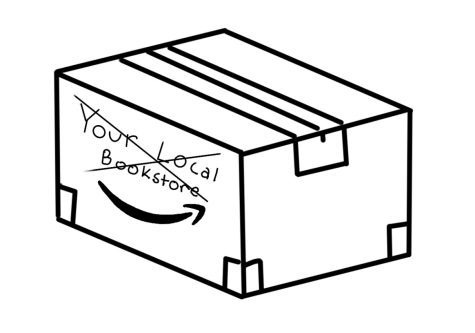Amazon has become the bookend to in-person spending
May 11, 2023
Since 2001, my family has placed 1,602 orders on Amazon, 18 percent of those being books. I had not understood the issue until I tried to use my Barnes and Noble membership a month ago. Realizing that it had been canceled five years prior made me aware that I had fallen victim to the ‘buy now with one click’ button.
When I mentioned my issues with Amazon to my friends, the first comments I got were, “What? Amazon is great!” As Amazon is widely known and used, its convenience can overshadow the real flaws of the company and the effect it has throughout different areas. Although Amazon creates a more convenient way to purchase everyday goods, the company wipes out more jobs than it creates and damages the economy as well as small businesses.
Since Amazon’s opening in 1994, sales have consistently risen, with one of their peaks being in 2020 at a high of $386.064 billion in revenue. One successful component of Amazon is its low prices in competition with other retailers and vendors. The other day I went to Costco with my mom, who was set on purchasing Michelle Obama’s “The Light We Carry” which usually retailed for $32. After arriving at the book section, we saw that the book had been marked down to $26. Meanwhile, Amazon had an even larger deal, at 35 percent off. This speaks to its ability to shrink prices, even against its common bargain-friendly competitors (like Costco), making the company more accessible and convenient for buyers. This creates a desire for people to continue to support Amazon which consequently is jeopardizing the jobs of others.
By cutting out work for various employees, Amazon creates a counterproductive impact on the economy. As Amazon penetrates more businesses, its lack of awareness leads to higher unemployment rates, leaving a negative effect on the economy and the lives of those without jobs.
According to the Institute for Local Self-Reliance, as Amazon has grown, the number of independent businesses has fallen. Between 2007 and 2017, the number of small retailers fell by 65,000; and about 40 percent of the nation’s goods makers disappeared – along with about one-third of small book publishers. As these platforms for shopping close, they take with them thousands of jobs, which only adds to the already ongoing upset around the globe. When Amazon replaces the services and goods that these places provide, the need for them plummets leaving many affected and jobless.
In addition to Amazon creating an interference with retailers’ success, it also has come close to shattering the bookstore industry, including both independent and chain stores. With the recent closure of Barnes and Noble in Corte Madera on March 12, questions have arisen about the rationale for the sudden shutdown. As the popularity of Amazon grew during the COVID-19 pandemic, Barnes and Noble struggled to keep their brick and mortar stores up and running. As only 13 percent of Barnes and Nobles’ sales are online, the company began to take a turn for the worse during the pandemic, having to fire over 23,000 employees. James Daunt, the chief executive officer of Barnes and Noble, issued a letter to such workers when COVID-19 had temporarily shut down 400 of the 627 stores in the U.S.
“With the closure of stores, we are obliged to make the hardest of choices,” Daunt said “This is a devastating situation in which to find ourselves and we understand the personal impacts of such action.”
Of course, Amazon was not at fault for the pandemic, but their accessibility for people wanting to stay home created less of a demand for shopping online at Barnes and Noble and other retailers that have online stores available.
Although Amazon continues to remove jobs of people working at other businesses, from 2020-2021, the number of employees at Amazon went up by 23.8 percent. During COVID-19 before this number eventually began to slowly plummet, Amazon was able to provide people with jobs who had previously lost theirs at the height of the pandemic. In times of crisis when cities were in lockdown, Amazon would provide a convenient delivery service offering next-day delivery with a Prime membership helping people through 2020. Even before this, Amazon had continued being a vital resource for people who were unable to shop in person or who wanted their shopping done in one place.
Though Amazon is thought to create mediocre opportunities for employees, such as a steady income with average pay, conditions in both the office and the warehouse are far from pleasant. According to an investigation by ABC-7, researchers found that the Occupational Safety and Health Administration (OSHA) had discovered complaints such as “a grueling pace, uncomfortable heat and the potential for injury.” In addition, more OSHA reports have found that a day in a delivery person’s life can be inhumane in some rural areas due to the limited access to restrooms along the way. Not only do the people working on the road and in warehouses struggle during the day, but according to an interview done by the New York Times with Bo Olson, who worked in book marketing at Amazon, their corporate jobs can be just as enervating.
“Nearly every person I worked with, I saw cry at their desk,” Olson said.
Even the employee relationships are rocky, as they take critical comments to the next level, being told to tear each other’s ideas apart at meetings. From 2021 to 2022, the number of Amazon employees dropped by 4.17 percent due to the work environment.
Instead of having the “must have” mindset, we as a community should be aware of the outcome of our economic footprint and try shopping locally or directly from a seller. As Amazon has become the commodity that most people around the world and especially in the Bay Area, have depended on, we should be able to shop sustainably without having consequences on our economy and the livelihood of others.







